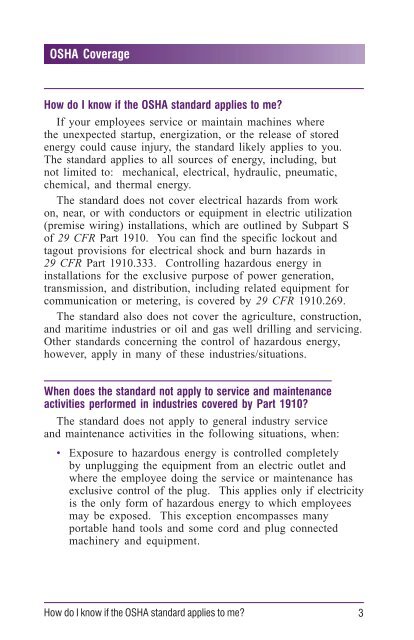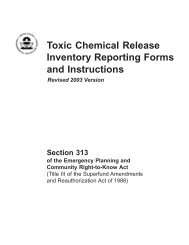(Lockout/Tagout) (revised 2002) OSHA 3120 - Seton
(Lockout/Tagout) (revised 2002) OSHA 3120 - Seton
(Lockout/Tagout) (revised 2002) OSHA 3120 - Seton
You also want an ePaper? Increase the reach of your titles
YUMPU automatically turns print PDFs into web optimized ePapers that Google loves.
<strong>OSHA</strong> Coverage<br />
How do I know if the <strong>OSHA</strong> standard applies to me?<br />
If your employees service or maintain machines where<br />
the unexpected startup, energization, or the release of stored<br />
energy could cause injury, the standard likely applies to you.<br />
The standard applies to all sources of energy, including, but<br />
not limited to: mechanical, electrical, hydraulic, pneumatic,<br />
chemical, and thermal energy.<br />
The standard does not cover electrical hazards from work<br />
on, near, or with conductors or equipment in electric utilization<br />
(premise wiring) installations, which are outlined by Subpart S<br />
of 29 CFR Part 1910. You can find the specific lockout and<br />
tagout provisions for electrical shock and burn hazards in<br />
29 CFR Part 1910.333. Controlling hazardous energy in<br />
installations for the exclusive purpose of power generation,<br />
transmission, and distribution, including related equipment for<br />
communication or metering, is covered by 29 CFR 1910.269.<br />
The standard also does not cover the agriculture, construction,<br />
and maritime industries or oil and gas well drilling and servicing.<br />
Other standards concerning the control of hazardous energy,<br />
however, apply in many of these industries/situations.<br />
When does the standard not apply to service and maintenance<br />
activities performed in industries covered by Part 1910?<br />
The standard does not apply to general industry service<br />
and maintenance activities in the following situations, when:<br />
• Exposure to hazardous energy is controlled completely<br />
by unplugging the equipment from an electric outlet and<br />
where the employee doing the service or maintenance has<br />
exclusive control of the plug. This applies only if electricity<br />
is the only form of hazardous energy to which employees<br />
may be exposed. This exception encompasses many<br />
portable hand tools and some cord and plug connected<br />
machinery and equipment.<br />
How do I know if the <strong>OSHA</strong> standard applies to me?<br />
3
















